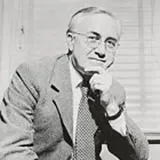
Professor James Danielli (1911 – 1984)
Biography
A model of the cell membrane - the basis of modern pharmacology
In 1949 James Danielli was appointed as Professor of Zoology at King's College, London. He remained there for more than a decade, assembling a team of talented young scientists, extending his earlier work on the cell membrane, and becoming involved in the development of anti-cancer drugs. It was a particularly fertile moment at King’s, with John Randall, Jean Hanson, Maurice Wilkins and Rosalind Franklin working in neighbouring departments.
Danielli is best known for the Davson–Danielli (or ‘sandwich’) model of the cell membrane. With Hugh Davson, he investigated the mechanisms that made the membranes of red blood cells selectively permeable. The model the two researchers first proposed in 1943 is the basis for modern understanding of how drugs enter cells – and thus for much later physiological and pharmacological research. They are commemorated in King’s Davson-Danielli Prize for Physiology.
Danielli’s early work was on the structure of the living cell membrane, membrane permeability and function. During the war, he was involved in research on the problems of wound healing and on the search for an antidote to the chemical warfare poison Lewisite. Later in life, he studied environmental health issues such as waste-water treatment and water pollution and campaigned for the preservation of the DNA of endangered species.
